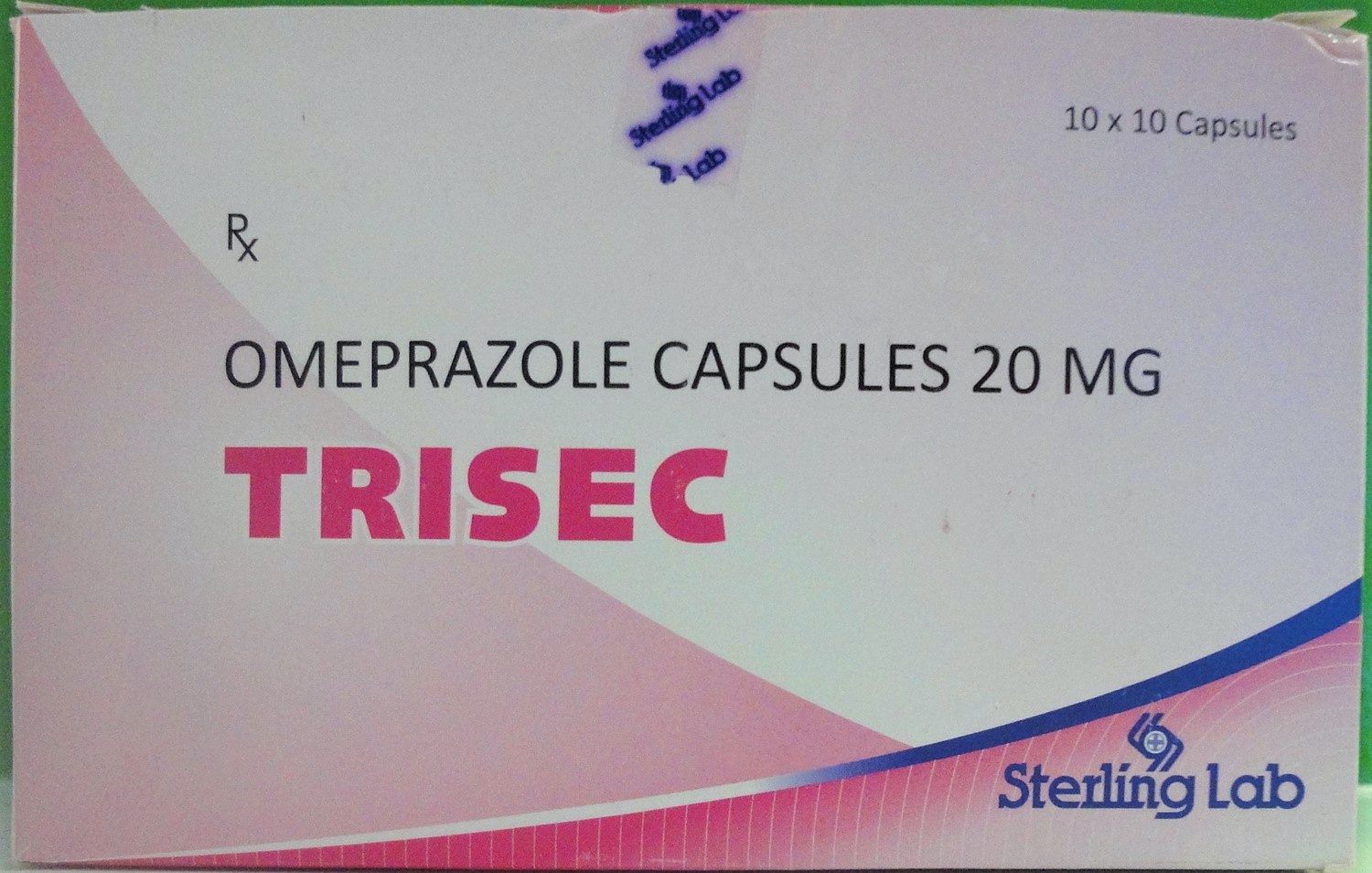TRISEC Capsule
ក្រុមហ៊ុនផលិតឱសថ:
Sterling Lab, India

- សារធាតុសកម្ម
- ប្រសិទ្ធិភាពព្យាបាល និង កម្រិតប្រើប្រាស់
- ហាមប្រើ
- ផលរំខាន
- អន្តរប្រតិកម្ម
- ស្ត្រីមានផ្ទៃពោះ និង ស្ត្រីបំបៅដោះកូន
- ការប្រុងប្រយ័ត្នជាពិសេស
- សកម្មភាពឱសថ បរិយាយប័ណ្ណឱសថ
-
សារធាតុសកម្ម
Omeprazole 20mg
-
ប្រសិទ្ធិភាពព្យាបាល និង កម្រិតប្រើប្រាស់
In the treatment of Duodenal and gastric ulcers, Reflux or ulcerative oesophagitis, Zollinger Ellisons syndrome.
Omeprazole, in combination with Clarithromycin and Amoxycillin, are indicated for the treatment of H.Pylori infections.
Trisec capsules are indicated for short-term treatment (4-8 weeks) of active benign gastric ulcer.
Trisec capsules are indicated for the treatment of heartburn and other symptoms associated with Gastroesophageal Reflux Disease (GERD).
Trisec capsules are indicated for the short-term treatment (4-8 weeks) of erosive esophagitis.
Trisec capsules are indicated for the long-term treatment of pathological hypersecretory conditions (e.g. Zollinger Ellison syndrome, multiple endocrine adenomas and systemic mastocytosis).
Dosage
In gastric ulcers, 20mgs once daily for 8 weeks, Increased to 40mgs daily in severe cases.
Reflux oesophagitis: 20ms once daily for 4 weeks.
Gastric ulcers: 20mg once daily for 4 weeks.
Zollinger Ellison syndrome: 40-60mgs once daily. Over 80mg should be divided in 2 doses.
-
ហាមប្រើ
Hypersensitivity to any of the ingredients.
Safety in pregnancy and lactation has not been established.
-
ផលរំខាន
The most commonly reported side-effects are: Nausea/vomiting, headache, diarrhoea, constipation, abdominal pain and flatulence, rash and/or pruritis, dizziness, paraesthesia, somnolence, insomnia, vertigo, increased liver enzymes and malaise.
The following have occurred in a few cases:
Skin: Photosensitivity, erythema multiforme, alopecia.
Central and peripheral nervous system: Arthralgia, muscular weakness, myalgia, reversible mental confusion, agitation, depression, and hallucinations, mostly in severely ill patients.
Gastrointestinal: Dry mouth, stomatitis and gastrointestinal candidiasis.
Hepatic: Encephalopathy in patients with pre-existing severe liver disease, hepatitis with or without jaundice, hepatic failure.
Increases in liver enzymes have been observed.
Endocrine: Gynaecomastia.
Haematologic: Leukopenia and thrombocytopenia.
Other: Hypersensitivity reactions, e.g. urticaria, angioedema, fever, bronchospasm and interstitial nephritis. Increased sweating, peripheral oedema, blurred vision and taste disturbance.
Other effects related to acid inhibition: During long-term treatment gastric glandular cysts have been reported to occur more frequently. These changes are benign and seem to be reversible and are a physiological consequence of pronounced inhibition of acid secretion. If a gastric ulcer is suspected, the possibility of malignancy should be excluded as treatment may mask the symptoms and delay diagnosis.
-
អន្តរប្រតិកម្ម
Omeprazole can prolong the elimination of medicines which are metabolized by oxidation in the liver, e.g. warfarin, diazepam and phenytoin.
Patients receiving warfarin or phenytoin concomitant with Omeprazole, should be monitored closely as a reduction in dosages of warfarin or phenytoin may be required.
It was however shown in patients on concurrent Omeprazole treatment at a daily dosage of 20mg and continuous phenytoin treatment, that the simultaneous use of these two medications did not influence the blood concentration of phenytoin. Concomitant treatment with Omeprazole 20mg daily also did not alter coagulation time in patients on long-term treatment.
There is a possibility of interactions with medicines metabolised via the cytochrome P450 enzyme system, although no interactions with propranolol, metoprolol, theophylline, lignocaine, quinidine and Amoxycillin have been recorded.
No interaction with food or the concurrent administration of antacid medications has been found.
The plasma concentrations of both omeprazole and clarithromycin may be increased during concomitant treatment with these medicines.
An increase of approximately 10% in the bioavailability of digoxin was recorded in healthy volunteers due to the increase in intragastric pH when Omeprazole and digoxin are administered concurrently.
-
ស្ត្រីមានផ្ទៃពោះ និង ស្ត្រីបំបៅដោះកូន
Safety in pregnancy and lactation has not been established.
-
ការប្រុងប្រយ័ត្នជាពិសេស
Treatment with Omeprazole may lead to a slightly increased risk of stomach infections such as salmonella, due to the decreased acidity i the stomach and also Omeprazole can mask the symptoms of stomach cancer and therefore delay diagnosis of this condition.
-
សកម្មភាពឱសថ
Omeprazole is a specific inhibitor of the gastric proton pump in the parietal cell and thus reduces the secretion of gastric acid. Reversible control of gastric acid secretion is produced with single daily doses of Omeprazole. Omeprazole is a weak base, which is concentrated in the intracellular canaliculi of the parietal cell. Due to the acidic environment in these cells, Omeprazole is converted to the active form, where it acts as an inhibitor of the enzyme H+K+-ATPase - the proton pump. There is a dose dependency on this final step in the formation of gastric acid, which provides for effective inhibition of the secretion of both basal acid and stimulated acid irrespective of the secretatory enhancer.
Omeprazole has no pharmacological effect on acetylcholine, histamine or gastrin receptors.
Effect on Gastric Secretion
When omeprazole is given daily as a single oral dose, the gastric acid secretion is inhibited with a maximum effect reached within four days of treatment. In patients with duodenal ulcers, a mean decrease of approximately 80% in intragastric acidity is then maintained over a 24-hour period, with the mean decrease in peal acid output after pentagastrin stimulation being approximately 70%, 24-hours after initiating treatment with Omeprazole.
*ព័ត៌មានឱសថត្រូវបានរៀបរៀងដោយ អ៊ីម៉ាតុគឹ មេឌីក (ខេមបូឌា) ដោយផ្អែកលើប្រភពព័ត៌មានខាងក្រោម។ សម្រាប់ព័ត៌មានលម្អិត សូមស្វែងរកនៅក្នុងក្រដាសព័ត៌មាននៃឱសថនីមួយៗ ឬ សាកសួរទៅកាន់ក្រុមហ៊ុនឱសថឬតំណាងចែកចាយនៃឱសថនីមួយៗ។
ប្រភពព័ត៌មាន៖
- ក្រដាសព័ត៌មាននៃឱសថសម្រាប់អ្នកជំនាញវេជ្ជសាស្ត្រដែលប្រើប្រាស់នៅប្រទេសជប៉ុន (Pharmaceutical and Medical Devices Agency, Pmda): https://www.pmda.go.jp
- ព័ត៌មានសង្ខេបនៃឱសថសម្រាប់អ្នកជំងឺដែលប្រើប្រាស់នៅប្រទេសជប៉ុន: http://www.rad-ar.or.jp
